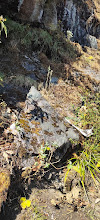Kharchen Dra
 |
| P.C Rinchey Rinchey (Facebook) |
A small painting-like place is Guru’s hidden land, supremely located overlooking faces to the hamlet known as Tsaling under Bumdeling gewog in Trashi Yangtse. The village is named after the legend according to which a giant named Sang Gagpa Samdrup, whom upon the arrival from Tibet with a bagful of salt had to share his salt to the people of that nameless village. Surprisingly, he had distributed single salt rock to whole province and thus the name Tsaling, which literally means ‘Salt rock distributed to the people of boundless community’ (Tsa-Salt and Ling-boundless community). The village at present is accessible to motorable road and takes about 30 minutes-drive from Trashi Yangtse town.
 |
| P.C. Rinchey Rinchey (Facebook) |
To
reach Kharchen Dra (cliff), one must travel from Tsaling by foot, pilgrims can
encounter a gateway towards Kharchen Dra. The site is instantly recognizable by
its entirely unique with precious jewels of concealed treasures. In the most
detailed account, the paradisal valley is concealed with treasures in mountains
or narrow gorge such as cremation ground Silwatsel, miraculously
originated Buddhist drum and white conch, Guru’s meditation cave, shrine of Zambala
(God of wealth), hidden treasure of salt, Roo (corpse) Ngedrupchen,
Dorji Phagmo’s (Vajravarani in Skt.) cave, remains of scattered brain of
vanquished demon, Matamuruta, Guru’s footprint, raven, foot impression
of Zambhala, tiger-faced mermaid and longevity vase. Behind Kharchen
Dra, towards left lies a shrine which is believed to be the place where deity Hum
Kala and his wife resided. Inside
the cave is a secret passage where pilgrims can receive blessings and cleanse
sins accumulated by crawling through secret passageway in the cave. Bhutanese strongly believe that crawling through a narrow chamber leave one’s sins behind without an iota of doubt and offers
healing experience.
Nye Pelritse
Set
in beautiful ridges, it is Pelritse, an abandoned mute site otherwise is deeply associated
to Guru Padmasambhava. The journey towards Pelritse takes two days from Rigsum Goenpa
and unlike other sites, Pelritse provides indescribable view from the hill
overlooking the base of valley. Rabselphu is a common place for pilgrims to halt
night and then the next day, people reach to the site after two day-long uphill
climb. Remoteness of the site and treacherous journey along the inhospitable
terrains had less attracted the visitors since few decades. Hidden deep in the folds of snow laden
mountains, Pelritse never fails to marvel its existence to visitors resounding
every untouched history and unparalleled beauty of fascinating landmarks. Distinct
from sightseeing trek, visit to the site itself help desolates regain qualms of
conscience and find solace albeit worldly life. A must visit site imbued with
significance and power set foot onto the area, allowing pilgrims to receive
blessings and attain salvation. From numerous rocks, lakes and cliffs at the
site, the trinity lakes, peaks and statues like figure gave birth to the name,
Rigsum Goenpa.
Main
treasures endowed with spiritual blessings include sacred lakes of Phurpa (Kila
in Sanskrit), Phagmo (Chakrasamvara in Skt.), Tsepame (Buddha of countless life),
White Dolma (Tara in Skt.), Blue Dolma (Tara in Skt.) and Goenpo Maning
(Mahaksla in Skt.). Treasures are in sheer mysticism extend across a whole
valley located inside dense forest and the place is the abode of treasures such
as Zangdopelri (copper plated mountain), sacred site of twenty-one Dolma (Tara
in Skt.) and Guru’s Lhakhang (Temple). The site is also reputed containing the
shrines of Namthoesaey (the god of wealth), Tsheringma (Five sisters of long
life), and the shrine of Rigsum Goenpa’s deity, Goenyen Phaenbu. Worshipped by
all pilgrims, holy place is particularly popular as it holds reputed Neys
especially overhanging cliffs of Nima and Dawa (twin cliff).
The
holy site may not be like paradise, but it is very close to be called as last
Shangri-La, just as the place is powerful and conducive for spiritual
development. Spiritual personnel seeking self-transformation, human wellbeing, and
happiness is advisable to visit only in sixth and seventh month of lunar
calendar considering the difficulties due to harsh forces of heavy snow
coverage.


No comments:
Post a Comment